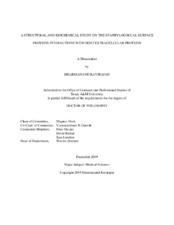| dc.description.abstract | Staphylococcus aureus (S. aureus), a gram positive bacterium, expresses multiple surface proteins (MSCRAMMs) that target host proteins for its colonization on the host tissue and later for the pathogenesis. ClfA is a virulence factor that interacts with fibrinogen (Fg) and the interaction of ClfA with the Fg is crucial for the pathogenesis. The virulence potential of ClfA/Fg interactions in the pathogenesis of S.aureus had been proven in sepsis and endocarditis infection animal models. ClfB is a chief colonizing factor that interacts with multiple host proteins like loricrin, cytokeratin-10, dermokine and Fg. The binding mechanism and structure of the ClfB:Ln complex is crucial for designing inhbitors against ClfB that aid in preventing the host colonization of S. aureus. My thesis work includes two chapters (1) crystal structure of ClfA with a proteolytic fragment of Fg (FgD). (2) Crystal structure of ClfB in complex with Ln. Chapter-1 results describe the structure of ClfA/FgD complex and identify the residues involved in the interactions of ClfAcc and Fg. The results of this chapter explains the structural basis for the fg mediated virulence of ClfA and the mechanism of Fg interactions of ClfA of S. aureus and its functional homologs fbl of S. lugdunensis and SpsD of S .pseudintermedius. The ClfAcc interacting region in Fg overlaps with the M1 protein of S. pyogenes and Fg interacting site in ClfA overlaps with the ‘tefibazumab’ interacting site. Chapter-2 results describe the structure of the ClfB/Ln complex and the mechanism of ClfB/Ln interactions. Comparison of ClfB/Ln structure with other ClfB ligand peptide complexes (Ck10, DK and Fg) shows that ClfB/Ln binding mechanism is unique and different from the previously known Dock, Lock and Latch mechanism of ClfB ligand binding.
My study was the first structure to show that, the Ln peptide can induce the dimerization of ClfB which is not observed in the interaction of ClfB with other known ligands. Furthermore, the crystal structure led to the discovery of an additional ligand binding site on top of the N3 subdomain in ClfB which is also present in other MSCRAMMS that forms the basis for chapter-1. | en |


